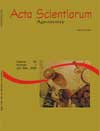<b>Total soil carbon and chemical attributes under different land uses in the Brazilian savanna</b> - DOI: 10.4025/actasciagron.v31i4.792
Keywords:
soil fertility, no-tillage, conventional tillage, pasture, soybean
Abstract
The Brazilian savanna region (Cerrado) is one of the largest cultivated areas of the world. The different land uses in the region can effectively change the quantities of soil organic matter and the cycling of nutrients. The objective of this study was to evaluate the effect of different land use management systems on the relationship between soil organic carbon and the soil chemical attributes of a Red Latosol (Oxisol) under Cerrado in Rio Verde (Goiás state). The treatments studied were native vegetation (cerradão), low-productivity pasture, conventional tillage with soybean, and no-tillage with soybean and maize. The smallest values for pH, available P, K, Ca and Mg were observed for the Cerradão treatment, even if the relatively high C levels increased the potential soil cation exchange capacity. The pasture, conventional tillage and no-tillage treatments showed higher K, Ca, Mg, available P, and S concentrations in the soil. In the areas where soil tillage did not take place and lime and fertilizers were applied superficially, the stratification of the soil organic carbon provides the retention of the elements near to the surface, with significance correlations with the soil chemicals attributes.Downloads
Download data is not yet available.
Published
2009-08-28
How to Cite
Siqueira Neto, M., Piccolo, M. de C., Scopel, E., Costa Junior, C., Cerri, C. C., & Bernoux, M. (2009). <b>Total soil carbon and chemical attributes under different land uses in the Brazilian savanna</b> - DOI: 10.4025/actasciagron.v31i4.792. Acta Scientiarum. Agronomy, 31(4), 709-717. https://doi.org/10.4025/actasciagron.v31i4.792
Issue
Section
Soils
DECLARATION OF ORIGINALITY AND COPYRIGHTS
I Declare that current article is original and has not been submitted for publication, in part or in whole, to any other national or international journal.
The copyrights belong exclusively to the authors. Published content is licensed under Creative Commons Attribution 4.0 (CC BY 4.0) guidelines, which allows sharing (copy and distribution of the material in any medium or format) and adaptation (remix, transform, and build upon the material) for any purpose, even commercially, under the terms of attribution.
2.0
2019CiteScore
60th percentile
Powered by 

2.0
2019CiteScore
60th percentile
Powered by 



















































